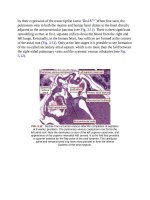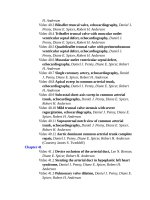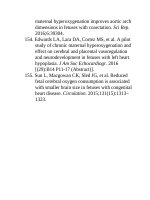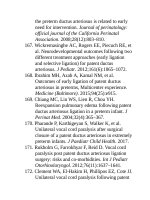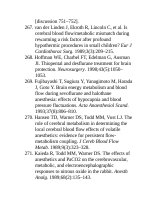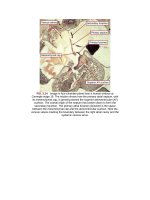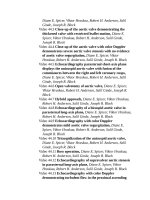Andersons pediatric cardiology 1854
Bạn đang xem bản rút gọn của tài liệu. Xem và tải ngay bản đầy đủ của tài liệu tại đây (115.43 KB, 3 trang )
mL/kgperdayor1to2mL/h)earlyinthepostoperativeperiod,whereasothers
allowastrategyoforalfeedingwiththevolumedeterminedbythe
neonate.4,17,148–156TPNiscontinueduntilcontinuousenteralfeedsareadvanced
togoal.Laterintherecoveryperiod,oralenteralfeedsmaybeattempted,but
onlyaftertheevaluationoforal-motorcoordinationandaspirationrisk.
Advancementoffeedsmaybedifficultinthesettingofprotracted
cardiorespiratoryfailure,feedingintolerance,orvocalcordparesisfollowing
archreconstruction.Theprophylacticuseofantirefluxmedications,while
common,mayalterthemicrobiomeofthegut,increasetheriskofinfection,and
increasetheriskofnecrotizingenterocolitis.
ThepalliatedneonatewithafUVHisathighriskforthedevelopmentof
necrotizingenterocolitis.Riskfactorsincludediastolicrunofffroman
aortopulmonaryshunt,ischemicinjuryfromcardiopulmonarybypass,high-dose
infusionsofvasoactivedrugs,thromboembolitothesystemiccirculation,
decreasedgastricmobility,andanatomicanomaliesofthegastrointestinaltract;
thesepredisposethiscohorttoanincreasedriskofgutmalperfusion.Thereisan
increasedriskofnecrotizingenterocolitisinlow-birth-weightandpremature
infants.InneonateswithafUVHwhodevelopnecrotizingenterocolitisinthe
postoperativeperiod,lengthofstayislongerandmortalityratesareashighas
25%.Giventhisrisk,enteralfeedadvancesareoftendeferreduntilthereis
sustainedevidenceofadequatesystemicDO2andareductioninvasoactive
infusionrates.Aprotocolizedapproachtoenteralfeedadvancesmayreducethe
riskofnecrotizingenterocolitis.Carefulmonitoringforevidenceofanyevolving
abdominalpathologyiswarranted.Feedintolerance,changesinabdominalgirth,
guaiac-positivestools,unexplainedmetabolicacidosis,orthrombocytopenia
maybeearlyindicatorsofnecrotizingenterocolitisandshouldpromptacareful
abdominalexaminationandradiographicevaluation.Thebedsideclinician
shouldmaintainalowthresholdformedicalmanagementofsuspected
necrotizingenterocolitis,includingdiscontinuationoffeedsandantibiotic
therapy.Consultationwithageneralsurgeryteamisoftenindicated.149,157–159
DeviationsFromtheExpectedPostoperative
Course
ThepostoperativecoursefollowingsurgicaltreatmentoffUVHintheneonateis
morevariableandunpredictablethanperhapsanyothercongenitallesion.Much
ofwhatisknownoftheexpectedpostoperativecoursehasbeenlearnedfrom
patientsfollowingstageIpalliationforhypoplasticleftheartsyndromeand
variants.Nonetheless,themortalityandmorbidityrisksfollowinganisolated
aortopulmonaryshuntforneonateswithafUVHareverysimilar,whereasthe
typicalpostoperativecourseforneonatesfollowinghybridpalliationhasbeen
limitedtoonlyafewcenters.Forthepurposesofthefollowingsection,mostof
whatisdescribedhasbeenreportedinneonateswithhypoplasticleftheart
undergoingstageIreconstruction,buttheseobservationsareapplicabletoall
neonateswithafUVHandmultidistributioncirculation.Thesefindingsare
likelytochangeasneonatalmanagementevolves.
ForneonateswithafUVH,hospitallengthofstayisfrequentlymeasuredin
monthsratherthandaysorweeks;indeed,inmostlargeseries,hospitallengthof
stayisgreaterthan2monthsin15%to25%ofcases(Fig.71.8).14,102,105,160–162
Complicationssuchasfeedingdifficulties,vocalcordparesis,diaphragm
paresis,andsepsisarecommon;theyprolongtheinitialhospitalstay,increase
resourceutilization,andreducequalityoflifeinthesurvivors.105,159,163,164Most
importantly,theneedforcardiopulmonaryresuscitation,withorwithout
extracorporealmembraneoxygenation(ECMO),isapproximately10%to15%
inmostlargeseries.105,163,165–167
FIG.71.8 Analysisofthesingle-ventriclereconstructiontrialdatabase
showingtheimpactoftheweekdayversusweekendadmissionand
outcome.Intransplant-freesurvivors,hospitallengthofstaywassimilar
betweentheweekendandtheweekday.(FromJohnsonJT,SleeperLA,
ChenS,etal.Associationsbetweendayofadmissionanddayofsurgery
onoutcomeandresourceutilizationininfantswithhypoplasticleftheart
syndromewhounderwentstageIpalliation(fromthesingleventricle
reconstructiontrial).AmJCardiol.2015;116[8]:1263–1269.)
EvaluationandManagementofAcute
DecompensationAfterSurgery
ClinicaldeteriorationofthepostoperativepatientwithafUVHistypically
characterizedbythedevelopmentofinadequateQsandDO2andlessoftenbya
limitationofQpwitharterialhypoxemia.Themostfrequentetiologyisthe
developmentofventriculardysfunctionwithorwithoutAVvalveregurgitation.
IfventricularandAVvalvefunctionareintactitisunlikelythatsystemic
perfusionwillbelimited.However,ifventricularfunctionbeginstowane,the
inefficiencyofthemultidistributioncirculationbeginstomanifest.Evenwitha
“balancedcirculation”(Qp:Qsratioofabout1to1.5),thetotalcardiacindex
requirementmustexceed5to6L/minpersquaremetertomaintainadequateQp
andQs(seeChapter70).Thelimitationsofstandardhemodynamicparameters
andtheperfusionexaminationindeterminingtheadequacyofDO2havebeen
discussed,ashavetheutilityofvenousandNIRSoximetryandlactatelevels.
TheextenttowhichventricularsystolicandAVvalvefunctionarecompromised
maybeappreciatedwithechocardiography;however,itisimportantto
appreciatethateven“mildly”impairedsystolicfunctionand“mild”AVvalve
regurgitationareofconcernwhenoneconsiderstotalCOrequirements.
AlimitedQsandDO2stimulateneurohormonalactivation,which,ifdueto
impairedsystolicfunction,causesstrokevolumeandCOtodecrease.Inthe
multidistributioncirculation,thisiscompoundedbytheincreaseinSVR/PVR
ratiodrivingQpattheexpenseofQs,andapositivefeedbackcycleiscreated,
withfurtherdecreasesinQsdrivingfurtherincreasesintheSVR/PVR
relationship.IfQs/DO2isseverelylimitedandorhypotensionispresent,one
maychoosetoinitiatetherapywithepinephrine,asitprovidesunparalleled
inotropicsupportwithoutincreasingSVR.WithanincreasingQs/DO2and
adequatebloodpressure,afterloadreductionmaybeindicated,asitincreases
strokevolumeinproportiontothedegreeofsystolicdysfunctionandAV
regurgitationifpresent.Nonselectivevasodilatorsincreasestrokevolumeand
CO,Qp,CaO2,andQs,theneteffectbeingamarkedincreaseinDO2anda
